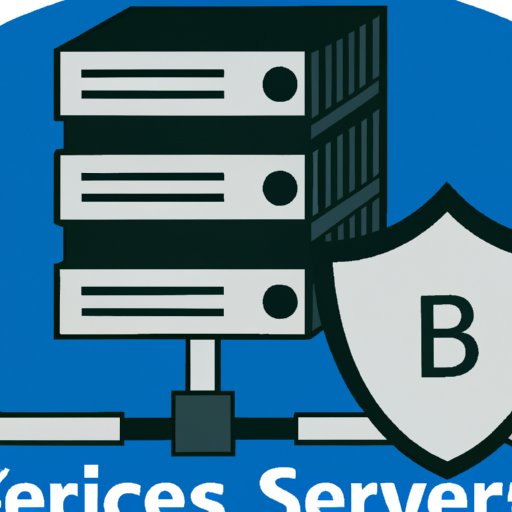Introduction
A server is a computer that is used to store, manage and process data for other computers in a network. It can be either a physical machine or a virtual machine and can serve multiple functions depending on its configuration. In this article, we will explore what a server is for computer, discussing the different types, the benefits and the risks associated with using one, as well as outlining the steps to setting it up.
Explaining What a Server Is and What It Does
A server is a computer that is designed to handle requests from other computers and provide them with the necessary resources. It is typically located on a secure network that is accessible only by authorized users. A server can serve multiple functions, such as providing access to the internet, storing files, managing databases and processing information.
When a user makes a request, the server processes it and sends back the requested information. This can include web pages, images, documents and other data. The server also stores and manages the data, ensuring that it is available when needed. This allows users to access the data quickly and reliably.

Describing the Different Types of Servers
There are several types of servers, each with its own set of features and capabilities. These include dedicated servers, virtual servers and cloud servers.
Dedicated Servers
A dedicated server is a physical machine that is dedicated to a single purpose. It is typically located in a secure facility and is maintained by a team of professionals. Dedicated servers are often used for high-traffic websites, as they offer more reliable performance and greater security than other types of servers.
Virtual Servers
A virtual server is a software-based server that runs on a virtualization platform. It is typically hosted on a cloud provider’s infrastructure and offers the same features and capabilities as a dedicated server. Virtual servers are often used for smaller businesses, as they are more affordable and easier to manage.
Cloud Servers
A cloud server is a type of server that is hosted on a cloud computing platform. It can be used for a variety of purposes, including hosting websites, managing databases and running applications. Cloud servers are popular due to their scalability, reliability and cost-effectiveness.

Discussing the Benefits of Having a Server
Having a server can offer many benefits, including increased efficiency, improved security and cost savings. Here are some of the advantages of having a server:
Increased Efficiency
Using a server can help improve the efficiency of your business operations. Having a centralized server allows you to easily access data from any location, reducing the need for manual tasks. This helps streamline processes and can save time and money.
Improved Security
Servers are typically located in secure facilities and are managed by experienced professionals. This means that the data stored on the server is protected from unauthorized access and malicious attacks. This can help keep sensitive information safe and secure.
Cost Savings
Having a server can also help reduce costs. By centralizing data storage and management, businesses can reduce their IT infrastructure costs. This can help lower overall expenses and increase profits.
Analyzing the Risks of Using a Server
Although there are many benefits to using a server, there are also some risks associated with it. These include vulnerability to cyber attacks and potential for data loss. Here are some of the risks associated with using a server:
Vulnerability to Cyber Attacks
As servers are connected to the internet, they are vulnerable to cyber attacks. Hackers can gain access to the server and steal or corrupt data. This can have a serious impact on businesses, resulting in financial losses and reputational damage.
Potential for Data Loss
Using a server also increases the risk of data loss. If the server fails or is damaged, the data stored on it could be lost. This can result in significant financial losses and disruption to business operations.

Outlining the Steps to Setting Up a Server
Setting up a server can be a complex process, but it is not impossible. Here are the steps that should be taken when setting up a server:
Choosing the Right Server
The first step is to choose the right server for your needs. Consider the type of data that needs to be stored, the number of users that will be accessing the server, and the budget available. This will help you determine which type of server is best suited for your requirements.
Installing the Necessary Software and Hardware
Once you have chosen the right server, the next step is to install the necessary software and hardware. This includes the operating system, database management system, networking software, and other applications. You may also need to purchase additional hardware, such as storage devices and servers.
Configuring the Server
After the necessary software and hardware has been installed, the server must be configured. This includes setting up the network, creating user accounts, and configuring security settings. This step is critical, as it ensures that the server is properly secured and functioning correctly.
Testing the Server
The final step is to test the server. This involves connecting to the server and testing the various components to ensure that everything is working as expected. Once the server has passed all tests, it is ready to be used.
Conclusion
In conclusion, a server is a computer that is used to store, manage and process data for other computers in a network. There are several types of servers, each with its own set of features and capabilities. Using a server can offer many benefits, including increased efficiency, improved security and cost savings. However, there are also some risks associated with using a server, such as vulnerability to cyber attacks and potential for data loss. Finally, setting up a server requires choosing the right server, installing the necessary software and hardware, configuring the server, and testing the server.


